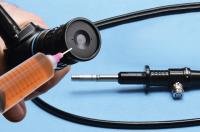
With the proliferation of infectious diseases such as the latest strain of the coronavirus i.e Covid-19 worldwide, there is a critical need to develop tests, which can detect patients who have contracted the disease. Master Bond has been developing specialty medical grade adhesives, sealants, coatings, impregnation materials, and encapsulation compounds for medical device companies, which are the forefront of designing and manufacturing instruments that can detect such diseases. Molecular diagnostic technology and instruments are widely employed and recognized as not only an efficient and fast method of detecting diseases, but also as an accurate and reliable tool.
Master Bond has been helping medical device customers over the years, and our products have been widely employed in biosensors, microfluidic applications, and in the assembly of diagnostic instruments. One example is our structural adhesive EP31, which was successfully used for bonding acrylic and aluminum components, in a molecular diagnostic instrument, for a non-instrumented nucleic acid amplification system.1
Many Master Bond products meet the USP Class VI and/or ISO10993-5 test requirements. Some examples of systems which meet both USP Class VI for biocompatibility and ISO10993-5 for cytotoxicity are:
| Product | Key Features | Typical Use |
| EP30Med | Two component room temperature curable, epoxy Low viscosity, and optically clear |
Biosensors2 Diagnostic tools |
| EP62-1Med | Two component, moderate heat curable, epoxy Highly sterilization resistant |
Electrosurgical equipment3 RFID equipment4 |
| EP42HT-2Med | Two component, room temperature curable, epoxy Repeated autoclave resistant |
Implantable sensors5 Drug delivery MEMS device6 |
| MasterSil 151Med | Two component room temperature curable, silicone Highly flexible |
Implantable electrical nerve stimulation equipment7 |
Sources
1Kubota, Ryo. Molecular Biosciences and Bioengineering, University of Hawaii at Manoa, Honolulu, HI. Diagenetics, Inc, Honolulu, HI; Labarre Paul. Program for Appropriate Technologies in Health (PATH), Seattle, WA. Weigl, Bernhard H. (PATH), Seattle, WA. Li, Yong. Nutrition, Food, and Animal Science, University of Hawaii at Manoa, Honolulu, HI. Haydock. Paul, Blood Cell Storage Inc (BCSI), Seattle, WA. Jenkins, Daniel M. Molecular Biosciences and Bioengineering, University of Hawaii at Manoa, Honolulu, HI. “Molecular diagnostics in a teacup: Non-Instrumented Nucleic Acid Amplification (NINA) for rapid, low cost detection of Salmonella enteric.” https://www.ncbi.nlm.nih.gov/pmc/articles/PMC4251779/
2To, Gary; Mahfouz, Mohamed. Center for Musculoskeletal Research The University of Tennessee. Qu, Wenchao; Islama, Syed K., Department of Electrical Engineering The University of Tennessee, Knoxville, TN. “Multi-channels wireless strain mapping instrument for total knee arthoplasty with 30 microcantilevers and ASIC Technology.” https://warwick.ac.uk/fac/sci/eng/research/grouplist/sensorsanddevices/mbl/database/ieeesensors08/PDFs/Papers/280_6396.pdf
3United States Patent Application Publication, Pub. No.: US 2013/0057390 A1. Pub. Date: Mar. 7, 2013. Radio Frequency Identification Tags For Use In Extreme Environments. Inventors: David Watt, Newark, CA. Fay, Stanford, CA. Jose Joseph, Palo Alto, CA.Karen Marie Nashold, San Francisco, CA. David Watters, Sunnyvale, CA. http://www.freepatentsonline.com/y2013/0057390.html
4United States Patent Van Wyk et al. Patent No.: US 8,486,064 B2. Date of Patent: Jul. 16, 2013. Electrosurgical Device Having Floating-Potential Electrode and Curvilinear Profile. Inventors: Robert A. Van Wyk, St. Pete Beach, FL. Yuval Carmel, Rockville, MD. Anatoly Shkvarunets, Rockville, MD.
5Baj-Rossi, C., et al. “Biocompatible Packagings for Fully Implantable Multi-Panel Devices for Remote Monitoring of Metabolism,” 2015 IEEE Biomedical Circuits and Systems Conference (BioCAS), Atlanta, GA, 2015, pp. 1-4. doi: 10.1109/BioCAS.2015.7348398. Accessed 17 Jan. 2018. https://icwww.epfl.ch/~demichel/publications/archive/2015/BioCAS-2015_Biocampatible-Packagings-(Camilla).pdf
6Yawen Lia, Rebecca S. Shawgo, Betty Tyler, Paul T. Hendersonc, John S. Vogel, Aron Rosenberg, Phillip B. Storm, Robert Langer, Henry Brem, Michael J. Cima. Department of Materials Science and Engineering, Massachusetts Institute of Technology, Cambridge, MA, Department of Neurological Surgery, Johns Hopkins University School of Medicine, Baltimore, MD, Biology and Biotechnology Research Program and Center for Accelerator Mass Spectrometry, Lawrence Livermore National Laboratory, Livermore, CA, Department of Chemical Engineering, Massachusetts Institute of Technology, Cambridge, MA. "In vivo release from a drug delivery MEMS device." September 2004. https://www.sciencedirect.com/science/article/abs/pii/S0168365904003827
7Moen, Lars Lyse. Norwegian University of Science and Technology, Department of Engineering Cybernetics. "An Implantable Device for Electrical Nerve Stimulation." July 2014.
Medical Grade Adhesives for Molecular Diagnostic Instruments
 |
EP30Med Biocompatible two component epoxy. USP Class VI approved. Low viscosity. Versatile cure schedules. Resists EtO, gamma radiation and cold sterilants. High strength rigid bonds. Serviceable from -60°F to +250°F. Can be used for indirect food contact per 175.105 FDA specification. |
 |
EP62-1Med Two part epoxy requiring moderate heat curing (80-120°C). Meets USP Class VI biocompatibility specifications. Superb resistance to repeated autoclaving along with excellent adhesion to high temperature plastics such as Ultem, PEEK, etc. Exceptionally long working life. Outstanding electrical insulation properties. Serviceable from -60°F to +450°F. |
 |
EP42HT-2Med Low viscosity, two part epoxy with outstanding chemical resistance. Passes USP Class VI biocompatibility tests. Capable of withstanding repeated sterilization cycles including radiation, EtO, chemical sterilants, autoclaving. Serviceable from -60°F to +450°F. Cures at room or elevated temperatures. Available in amber-clear and black colors. Castable in thicknesses up to 2-3 inches. |
 |
MasterSil 151Med Medical grade, USP Class VI approved silicone. Addition type cure system. Optically clear. Low outgassing. Offers ambient or elevated temperature cures. Excellent for potting and encapsulation applications. Low shrinkage upon cure. Resists gamma radiation, EtO and various chemical sterilants. Serviceable from -65°F to +400°F. |
 |
EP31 Ultra high strength, two part epoxy adhesive that bonds well to most metals and plastics. Aluminum to aluminum lap shear strength exceeds 4,000 psi. T-peel strength >50 pli. Ambient temperature curing. Tough and resilient bonds. Combines low viscosity and optical clarity. Serviceable from -60°F to +250°F. Chemical resistant. First class electrical insulator. |
